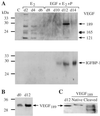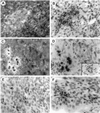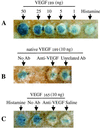A dynamic shift of VEGF isoforms with a transient and selective progesterone-induced expression of VEGF189 regulates angiogenesis and vascular permeability in human uterus
- PMID: 11972026
- PMCID: PMC122895
- DOI: 10.1073/pnas.082110999
A dynamic shift of VEGF isoforms with a transient and selective progesterone-induced expression of VEGF189 regulates angiogenesis and vascular permeability in human uterus
Abstract
A key mechanism underlying physiological angiogenesis of the human endometrium is its ability to regenerate the vascular capillary network and to perform vascular remodeling (i.e., development of spiral arteries). Vascular endothelial growth factor (VEGF) is associated with angiogenesis and capillary permeability in this tissue. VEGF is expressed as several spliced variants, its main human isoforms contain 121 and 165 aa; 17beta-estradiol (E(2)) increases endometrial VEGF, possibly in all isoforms. Here we show that progesterone (P) selectively increases the expression of the VEGF(189) (V(189)) isoform in the human uterus. V(189) is identified in the conditioned medium of stromal cells treated with E(2) + P; its presence in this in vitro model of decidual stromal cells is detected after 6-8 days, using ELISA, and after 8-10 days, using Western blot analysis with different antibodies, including one specific for V(189). The secretion pattern of V(189) parallels that of the decidual protein IGFBP-1. V(189) is secreted as a native isoform, as compared with the migration of recombinant V(189) by SDS/PAGE. In situ hybridization and immunocytochemistry(,) performed on the same biopsies, suggest that decidual cells express V(189) during the mid-late secretory phase of the menstrual cycle and early gestation. Finally, using an in vivo permeability assay, we show that native V(189) increases capillary permeability. These observations demonstrate that P regulates V(189) expression in decidual cells, which could have important implications for understanding uterine vascular remodeling and implantation, and may be relevant in a range of disease states such as edema and irregular bleeding.
Figures





Similar articles
-
Differential expression of VEGF isoforms and VEGF(164)-specific receptor neuropilin-1 in the mouse uterus suggests a role for VEGF(164) in vascular permeability and angiogenesis during implantation.Genesis. 2000 Mar;26(3):213-24. Genesis. 2000. PMID: 10705382
-
Expression of hypoxia-inducible factors in the peri-implantation mouse uterus is regulated in a cell-specific and ovarian steroid hormone-dependent manner. Evidence for differential function of HIFs during early pregnancy.J Biol Chem. 2003 Feb 28;278(9):7683-91. doi: 10.1074/jbc.M211390200. Epub 2002 Dec 12. J Biol Chem. 2003. PMID: 12482866
-
Ovarian steroids in endometrial angiogenesis.Steroids. 2000 Oct-Nov;65(10-11):599-603. doi: 10.1016/s0039-128x(00)00117-3. Steroids. 2000. PMID: 11108865
-
Expression of vascular endothelial growth/permeability factor by endometrial glandular epithelial and stromal cells in baboons during the menstrual cycle and after ovariectomy.Endocrinology. 2002 Oct;143(10):4007-17. doi: 10.1210/en.2002-220385. Endocrinology. 2002. PMID: 12239112
-
Differential expression of vascular endothelial growth factor and its receptor mRNAs in the mouse uterus around the time of implantation.J Endocrinol. 1995 Nov;147(2):339-52. doi: 10.1677/joe.0.1470339. J Endocrinol. 1995. PMID: 7490564
Cited by
-
Solving the Puzzle: What Is the Role of Progestogens in Neovascularization?Biomolecules. 2021 Nov 12;11(11):1686. doi: 10.3390/biom11111686. Biomolecules. 2021. PMID: 34827682 Free PMC article. Review.
-
DPSCs treated by TGF-β1 regulate angiogenic sprouting of three-dimensionally co-cultured HUVECs and DPSCs through VEGF-Ang-Tie2 signaling.Stem Cell Res Ther. 2021 May 10;12(1):281. doi: 10.1186/s13287-021-02349-y. Stem Cell Res Ther. 2021. PMID: 33971955 Free PMC article.
-
Neuropilin 1 Regulation of Vascular Permeability Signaling.Biomolecules. 2021 Apr 29;11(5):666. doi: 10.3390/biom11050666. Biomolecules. 2021. PMID: 33947161 Free PMC article. Review.
-
Effect of antiprogesterone RU486 on VEGF expression and blood vessel remodeling on ovarian follicles before ovulation.PLoS One. 2014 Apr 22;9(4):e95910. doi: 10.1371/journal.pone.0095910. eCollection 2014. PLoS One. 2014. PMID: 24756033 Free PMC article.
-
The regulation of ovary and conceptus on the uterine natural killer cells during early pregnancy.Reprod Biol Endocrinol. 2017 Sep 6;15(1):73. doi: 10.1186/s12958-017-0290-1. Reprod Biol Endocrinol. 2017. PMID: 28874155 Free PMC article. Review.
References
-
- Giudice L. In: Reproductive Endocrinology, Surgery and Technology. Adashi E Y, Rock J A, Rosenwaks Z, editors. Philadelphia: Lippincott–Raven; 1996. pp. 272–300.
-
- Perrot-Applanat M. In: Encyclopedic Reference of Vascular Biology and Pathology. Bikfalvi A, editor. Berlin: Springer-Verlag; 2000. pp. 157–162.
-
- Charnock-Jones D S, Sharkey A M, Rajput-Williams J, Burch D, Schofield J P, Foutain S A, Boocock C A, Smith S K. Biol Reprod. 1993;48:1120–1128. - PubMed
-
- Zhang L, Rees M C P, Bicknell R. J Cell Sci. 1995;108:323–331. - PubMed
-
- Torry D S, Holt V J, Keenan J A, Harris G, Caulde M R, Torry R J. Fertil Steril. 1996;66:72–80. - PubMed
Publication types
MeSH terms
Substances
LinkOut - more resources
Full Text Sources
Molecular Biology Databases

